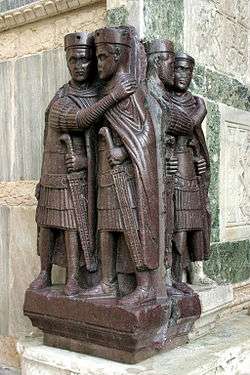Portrait of the Four Tetrarchs

The Portrait of the Four Tetrarchs is a porphyry sculpture group of four Roman emperors dating from around 300 CE. Since the Middle Ages it has been fixed to a corner of the façade of St Mark's Basilica in Venice, Italy. It probably originally formed part of the decorations of the Philadelphion in Constantinople, and was removed to Venice in 1204 or soon after.
Subject
The Roman Empire was for a time after 293 ruled by a tetrarchy (a group of four rulers), instituted by Emperor Diocletian. The tetrarchy consisted of two Augusti (senior emperors) and two Caesars (junior emperors). The empire was territorially divided into western and eastern halves, with a senior and a junior emperor in each half. After Diocletian and his colleague, Maximian, retired in 305, internal strife erupted among the tetrarchs. The system finally ceased to exist around 313.
The Portrait of the Four Tetrarchs symbolizes the concept of the tetrarchy, rather than providing four personal portraits. Each tetrarch looks the same, without any individualized characteristics, except that two, probably representing the older Augusti, have beards, and two do not who might have symbolized the Caesars. The group is divided into pairs, each embracing, which unites Augusti and Caesars together. The overall effect suggests unity and stability. The very choice of material, the durable porphyry (which came from Egypt), symbolizes a permanence of the kind reminiscent of Egyptian statuary and the early Kouros figures. Porphyry was rare and reserved for imperial use.[1][2]
Style
The figures are stout and blocky, far from the verisimilitude or the idealism of earlier Greco-Roman art. The figures are stiff and rigid, the attire being patterned and stylized. Their faces are repetitive and they seem to stare in a kind of trance. Comparing them to the slightly later reliefs on the Arch of Constantine in Rome, Ernst Kitzinger finds the same "stubby proportions, angular movements, an ordering of parts through symmetry and repetition and a rendering of features and drapery folds through incisions rather than modelling". Noting other examples, he continues "The hallmark of the style wherever it appears consists of an emphatic hardness, heaviness and angularity — in short, an almost complete rejection of the classical tradition".[3]
The question of how to account for what may seem a decline in both style and execution in Late Antique art has generated a vast amount of discussion. Factors introduced into the discussion include: a breakdown of the transmission in artistic skills due to the political and economic disruption of the Crisis of the Third Century,[4] influence from Eastern and other pre-classical regional styles from around the Empire (a view promoted by Josef Strzygowski (1862–1941), and now mostly discounted),[5] the emergence into high-status public art of a simpler "popular" or "Italic" style that had been used by the less wealthy throughout the reign of Greek models, an active ideological turning against what classical styles had come to represent, and a deliberate preference for seeing the world simply and exploiting the expressive possibilities that a simpler style gave.[6] One factor that cannot be responsible, as the date and origin of the Portrait of the Four Tetrarchs show, is the rise of Christianity to official support, as the changes predated that.[7] This shift in artistic style points towards the style of the Middle Ages.[8]
History
|
|
The statues probably originally decorated the columns of the porch of the Philadelphion in Constantinople. They were plundered by the Venetians when the city was sacked during the Fourth Crusade in 1204 and brought to Venice.[9] In the 1960s, the heel part of the missing foot was discovered by archaeologists in Istanbul close to the Bodrum Mosque. This part is in the Istanbul Archaeology Museum.
A different story is told by The Travels of Marco Polo, the famous Venetian's autobiography put to paper with the help of his co-writer, Rustichello of Pisa, around 1300. This story has to be treated with great caution, the source being far from reliable in modern terms:
A dispute which broke out at Acre in 1255 came to a head in a war which lasted for years, and was felt all over Syria. It began in a quarrel about a very old church called St. Sabba's, which stood on the common boundary of the Venetian and Genoese estates in Acre, and this flame was blown by other unlucky occurrences. Acre suffered grievously. Venice at this time generally kept the upper hand, beating Genoa by land and sea, and driving her from Acre altogether. Four ancient porphyry figures from St. Sabba's were sent in triumph to Venice, and with their strange devices still stand at the exterior corner of St. Mark's, towards the Ducal Palace."[10]
References
- ↑ Kitzinger, Ernst, Byzantine art in the making: main lines of stylistic development in Mediterranean art, 3rd–7th century, 1977, Faber & Faber, p. 9. ISBN 0571111548 (US: Cambridge UP, 1977)
- ↑ Tetrarchs, Il Museo di San Marco, 2013. Retrieved 5 April 2013.
- ↑ Kitzinger, 9 (both quotes)
- ↑ Kitzinger, 8–9
- ↑ Kitzinger, 9–12
- ↑ Kitzinger, 10–18
- ↑ Kitzinger, 5–6, 9, 19
- ↑ Kitzinger, 19
- ↑ Honour, H.; Fleming, J. (2009). A World History of Art (7th ed.). London: Laurence King Publishing. p. 309. ISBN 978-1-85669-584-8.
- ↑ Messenger, Charles, ed. (1929). The Travels of Marco Polo. The complete Yule-Cordier edition. John Murray, London – via Project Gutenberg.
External links
| Wikimedia Commons has media related to Statues of the Tetrarchs (Venice). |
Coordinates: 45°26′03″N 12°20′23″E / 45.43417°N 12.33972°E